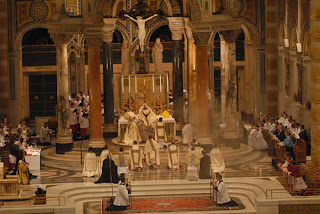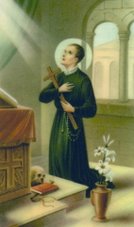 The Institute of Christ the King. I have linked to this traditional-style priestly order for some time on my Resources, and would recommend a closer look as I, too, am getting to know them. They have recently opened a house in Liverpool, and so at last have a presence in the UK. What is special about them? It is a society of apostolic life whose goal is the honour of God and the sanctification of priests in the service of the Church and souls. It has a specific missionary aim, with missions in Gabon, Africa as well as Europe and America. The mother-house and international seminary (under the patronage of St Philip Neri) is located in the Archdiocese of Florence in Northern Italy.
The Institute of Christ the King. I have linked to this traditional-style priestly order for some time on my Resources, and would recommend a closer look as I, too, am getting to know them. They have recently opened a house in Liverpool, and so at last have a presence in the UK. What is special about them? It is a society of apostolic life whose goal is the honour of God and the sanctification of priests in the service of the Church and souls. It has a specific missionary aim, with missions in Gabon, Africa as well as Europe and America. The mother-house and international seminary (under the patronage of St Philip Neri) is located in the Archdiocese of Florence in Northern Italy.But why does it have relevance to us? The Institute recognise the importance of beauty in the liturgy, as a means of drawing our attention to heavenly things through the harmony between faith, liturgy and life. The celebration of the 'extraordinary form' of the Roman Rite following the 1962 missal is the principle means with which they do this. There is also a community of religious sisters which was formed in 2004, "the Adorers of the Sacred Heart" under the patronage of St Madeleine Sophie Barat.
From their web-site:
Thirty-five houses in ten countries, fifty priests, and over sixty seminarians in fifteen years are perhaps sufficient proof that the Institute is on the right path within the Church. It is not our intent to grow quickly and to become mushroom-like, that is big and weak, but to consolidate our Institute by a careful selection of possible candidates and by an always-growing emphasis on a solid community life according to our own spirituality. We do not press our candidates into a typical uniformity of mind and expression, but again we follow St. Francis de Sales who commands us "to be good at what we are," which means that through the collaboration with the grace of God, everyone has to develop the different talents and gifts according to the will of the Lord and to eliminate from his character those traits that are opposed to the divine teachings. It is a combat for life but a fraternal community, the participation in the mysteries of the liturgy, and the continuous study of the marvelous tradition of the Church as reflected by Scripture and the Magesterium, which are the appropriate instruments that give us the strength never to cease in this battle but to look forward to it every day with renewed joy and confidence.
With his recent Apostolic letter, Summorum Pontificum the Vicar of Christ has not only encouraged the celebration of the Classical liturgy, but has also followed yet another theologically important tradition of Holy Mother Church called liberalitas Ecclesiae, the generous "liberality of the Church." This genuine liberality is the very reason we call the Church our Mother, because in the name and authority of the Blessed Lord she dispenses liberally all the graces her children need. She gives suum cuique, as the motto of the Holy See tells us, to everyone what he deserves. Never cheap, meticulous or narrow in the administration of the Divine riches entrusted to them, the Spouse of Christ and her visible head, His Vicar, want to grant free access to the treasures of grace contained in the first place in the sacramental instruments of sanctification to all who worthily request it. Hence, with nearly the entire history of the Church as background, the Bishop of the Universal Church wisely proceeded to lift all restrictions and obstacles that could hinder priests and faithful to access the wide field of grace open to them in the extraordinary form of the Latin Rite. His fatherly gesture merits forever our prayerful gratitude!
 Moreover, a deep experience of the Classical liturgy creates in me a yearning to be closer to it; to centre my life on it, and to bring my whole life to it, before the Cross itself. I am certain that these feelings are aroused in others, attending both forms of the Rite, and this can only be a good thing for the Church. However, a greater understanding and appreciation for the Classical liturgy will serve to orientate Priests and faithful towards a "rehabilitation" of the way Mass is commonly celebrated today. Many features are (or should be) open to a traditional interpretation: the orientation of the Priest (facing the same direction as the people - ad orientem) especially during the "Liturgy of the Eucharist"; the use of Latin; the use of silence (especially the 'silent canon'); the traditional offertory prayers; the prayers at the foot of the Altar; the traditional Confiteor... many of these features which are so desirable (I feel) can be incorporated immediately into the newer form of Mass. Others are forbidden and not allowed as they are a mingling of Rites (or so the previous declarations of the 1980s maintain). A good example of a very traditional and classical way of saying the ordinary form of Mass is at the Oratory's Sunday High Mass. I should reflect more on this at a later date: It is, in appearence, so similar to a Traditional High Mass, that one would be forgiven for not knowing the difference! The actual differences, and their consequences, that remain are worth highlighting, because they are the true and authentic developments which have been made to the Missal, and possibly called for by the Fathers of the Second Vatican Council.
Moreover, a deep experience of the Classical liturgy creates in me a yearning to be closer to it; to centre my life on it, and to bring my whole life to it, before the Cross itself. I am certain that these feelings are aroused in others, attending both forms of the Rite, and this can only be a good thing for the Church. However, a greater understanding and appreciation for the Classical liturgy will serve to orientate Priests and faithful towards a "rehabilitation" of the way Mass is commonly celebrated today. Many features are (or should be) open to a traditional interpretation: the orientation of the Priest (facing the same direction as the people - ad orientem) especially during the "Liturgy of the Eucharist"; the use of Latin; the use of silence (especially the 'silent canon'); the traditional offertory prayers; the prayers at the foot of the Altar; the traditional Confiteor... many of these features which are so desirable (I feel) can be incorporated immediately into the newer form of Mass. Others are forbidden and not allowed as they are a mingling of Rites (or so the previous declarations of the 1980s maintain). A good example of a very traditional and classical way of saying the ordinary form of Mass is at the Oratory's Sunday High Mass. I should reflect more on this at a later date: It is, in appearence, so similar to a Traditional High Mass, that one would be forgiven for not knowing the difference! The actual differences, and their consequences, that remain are worth highlighting, because they are the true and authentic developments which have been made to the Missal, and possibly called for by the Fathers of the Second Vatican Council.To be continued...!
First Picture ICK
Middle Two Photos ©2005-2007 Vernon Quaintance

















Non Christas sed Christus!
ReplyDeleteThank you! My mistake!
ReplyDelete